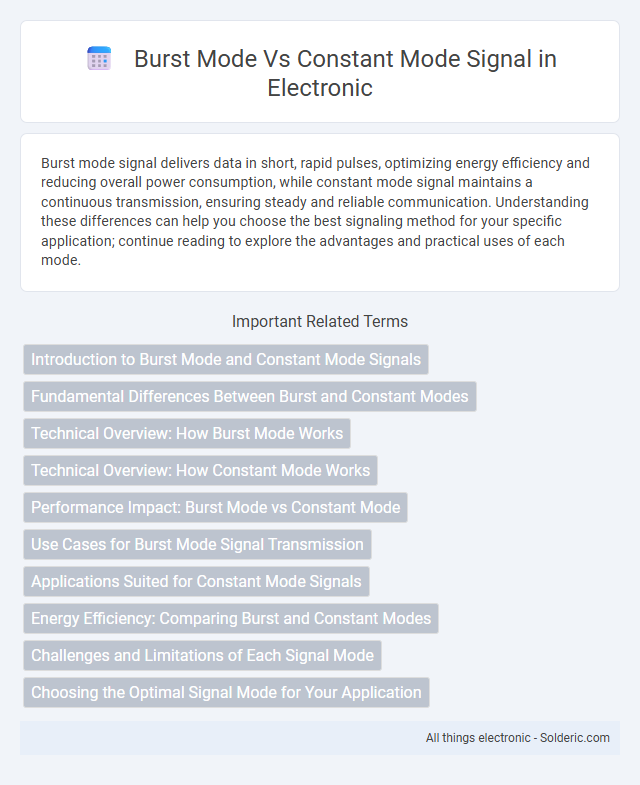Burst mode signal delivers data in short, rapid pulses, optimizing energy efficiency and reducing overall power consumption, while constant mode signal maintains a continuous transmission, ensuring steady and reliable communication. Understanding these differences can help you choose the best signaling method for your specific application; continue reading to explore the advantages and practical uses of each mode.
Comparison Table
| Feature | Burst Mode Signal | Constant Mode Signal |
|---|---|---|
| Signal Type | Intermittent pulses or bursts | Continuous, steady signal |
| Power Consumption | Lower average power consumption | Higher power due to constant transmission |
| Data Transmission | Data sent in rapid bursts | Data sent continuously |
| Interference | Reduced interference due to gaps | Possible higher interference risk |
| Use Cases | Radar, wireless sensor networks | Broadcast radio, continuous monitoring |
| Signal Stability | Variable due to pulse nature | Highly stable and consistent |
| Complexity | Requires timing control circuitry | Simpler generation hardware |
Introduction to Burst Mode and Constant Mode Signals
Burst mode signals consist of short, high-intensity pulses separated by periods of inactivity, optimizing energy efficiency and reducing thermal load in electronic circuits. Constant mode signals maintain continuous, steady-state output, providing stable and predictable performance in applications requiring consistent power delivery. Selecting between burst mode and constant mode depends on factors such as power consumption, signal integrity, and application-specific requirements.
Fundamental Differences Between Burst and Constant Modes
Burst mode produces signals in short, high-intensity pulses separated by intervals of no emission, optimizing power efficiency and reducing thermal load. Constant mode generates continuous, steady signals maintaining consistent output amplitude and frequency, ideal for applications requiring uninterrupted transmission. The fundamental difference lies in temporal emission patterns, where burst mode enables intermittent energy delivery, while constant mode sustains continuous signal propagation.
Technical Overview: How Burst Mode Works
Burst mode operates by transmitting a rapid series of signal pulses interspersed with periods of silence, allowing efficient data transfer while minimizing power consumption and interference. This mode enhances communication systems by sending data in concentrated bursts rather than a continuous stream, optimizing bandwidth utilization and reducing noise. Key technical components include timing control circuits and pulse generators that synchronize the burst intervals for precise transmission.
Technical Overview: How Constant Mode Works
Constant mode operates by delivering a steady, continuous signal without interruptions, ensuring consistent power output for electronic devices. This mode maintains a uniform voltage or current amplitude, which optimizes performance in applications requiring stable and reliable signal transmission. It contrasts with burst mode by avoiding periodic signal gaps, reducing signal distortion in sensitive measurements or communication systems.
Performance Impact: Burst Mode vs Constant Mode
Burst mode signals deliver data in rapid, high-intensity pulses, enhancing power efficiency and reducing average power consumption, which can improve system performance in intermittent traffic scenarios. Constant mode signals maintain a steady, continuous transmission, providing more stable signal integrity and lower latency, beneficial for real-time applications requiring consistent data flow. The performance impact depends on the specific application demands, with burst mode optimizing energy efficiency and constant mode favoring signal reliability and latency.
Use Cases for Burst Mode Signal Transmission
Burst mode signal transmission is ideal for applications requiring intermittent data transfer, such as wireless sensor networks and radar systems, where energy efficiency and reduced interference are crucial. It enables precise timing and synchronization in communication protocols, making it suitable for time-division multiplexing and burst data notifications. Your devices benefit from reduced power consumption and optimized bandwidth utilization when using burst mode signals in scenarios with sporadic or bursty data flows.
Applications Suited for Constant Mode Signals
Constant mode signals are ideal for applications requiring stable and continuous power delivery, such as in industrial machinery, communication systems, and medical devices where uninterrupted operation is critical. These signals provide a steady and predictable output, minimizing fluctuations that could disrupt sensitive equipment or processes. Your system benefits from enhanced reliability and consistent performance when using constant mode signals in settings demanding precise control and long-duration operation.
Energy Efficiency: Comparing Burst and Constant Modes
Burst mode signal transmission is more energy-efficient than constant mode because it transmits data in short, high-power bursts, reducing overall power consumption during idle periods. Constant mode requires continuous power output, leading to higher energy use regardless of data transmission activity. This makes burst mode particularly advantageous for battery-powered and low-energy communication systems.
Challenges and Limitations of Each Signal Mode
Burst mode signals often face challenges such as increased susceptibility to synchronization errors and higher peak power demands, which can strain hardware components and reduce system reliability. Constant mode signals provide stable power delivery and simpler timing control but may suffer from inefficient energy usage and limited flexibility in dynamic environments. Your choice between these modes should consider the trade-offs between precision timing and power efficiency to optimize system performance.
Choosing the Optimal Signal Mode for Your Application
Burst mode signals deliver short, high-intensity pulses ideal for applications requiring precise timing and energy conservation, such as radar and communication systems. Constant mode signals provide continuous output, offering stability and consistent power essential in processes like industrial heating and laser machining. Selecting the optimal signal mode depends on the application's need for power efficiency, precision, and operational continuity.
burst mode vs constant mode signal Infographic

 solderic.com
solderic.com